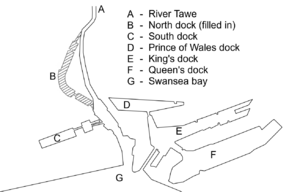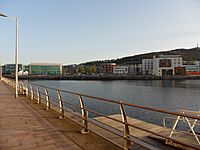Swansea docks facts for kids
Swansea Docks is the collective name for several docks in Swansea, Wales, which are immediately south-east of Swansea city centre. In the mid-19th century, the port was exporting 60% of the world's copper from factories situated in the Tawe Valley. The working docks area today is owned and operated by Associated British Ports as the Port of Swansea, and the northern part around the Prince of Wales Dock is undergoing re-development into a new urban area branded as the SA1 Swansea Waterfront.
Contents
Docks
Docks which have existed or still exist in the complex include:
North Dock
The North Dock was created to fulfil the increasing shipping demands from the nearby metals industry, and was created by diverting the River Tawe by cutting a new direct course within a meander section near the estuary. The old course of the river became the new dock and work was completed in 1852. ..... The North Dock closed in 1930 after the development of new larger docks on the east side of the River Tawe made it obsolete. The north dock has since been filled in and the Parc Tawe retail complex was built on the site in the late 1980s.
South Dock
Construction of the South Dock was begun in 1852 by a private company. It was built on a site west of the River Tawe, just south of the North Dock and was not completed until 1859. The South Dock was closed in 1971 and was redeveloped in the 1980s. The dock itself became the Swansea Marina and the land around the dock was developed as the Maritime Quarter residential area.
Prince of Wales Dock
The Swansea Harbour Trust began constructing the Prince of Wales Dock in 1879 on Fabian's Bay to the east of the River Tawe. When construction was completed, the Prince of Wales dock was opened on 18 October 1881 by Edward, Prince of Wales, and extended in 1898 to its present size of 27 acres (11 ha). Usage of the dock declined throughout the latter half of the 20th century. The Prince of Wales Dock is now being redeveloped as the Prince of Wales Marina with 500 berths. A new channel with sea lock and holding basin was built to link the marina directly with the River Tawe. A cable-operated wakeboarding facility opened in the Prince of Wales Dock in 2010, but was short-lived. The dock is the site of the swim section of the annual Swansea Triathlon.
King's Dock
Work began on the King's Dock in 1905 to meet the growing demand of tinplate exports from the local area. The King's Dock was constructed as a much larger dock than the Prince of Wales on the south side of the Prince of Wales Dock and covers some 72 acres (29 ha). Construction was complete by 1909. The King's Dock is the principal dock in the Port of Swansea which is still in use today for cargo operations.
Queen's Dock
At the same time as the King's Dock was being built, a breakwater was constructed further south which enclosed a large body of water, some 151 acres (61 ha). This body of water was opened in 1920 as the Queen's Dock after oil handling facilities were built to handle imports for the nearby BP oil refinery at Llandarcy and petrochemical plant at Baglan Bay. Usage of the Queen's Dock reached its peak in the 1950s when oil imports and exports were around 8 million tonnes per year. Since the closure of the plants at Baglan Bay and Llandarcy, the Queen's Dock was rendered obsolete as an oil handling facility and is now used for mussel farming.
History
Due to increases in industrial output and in trade in copper, zinc, iron and tinplate combined with the developments in shipping (big steamships were replacing smaller sailing vessels) by the late 19th century Swansea's harbour was in desperate need of expansion. The Swansea Harbour Trust (SHT) commissioned the construction of the Prince of Wales Dock, the first on the east side of the river. Opened in 1881 by the Prince and Princess of Wales (later Edward VII and Queen Alexandra), it was completed in 1882, and expanded in 1898. The North Quay frontage was let to the Great Western Railway, the Neath and Brecon Railway and the Rhondda and Swansea Bay Railway, which linked the Dulais Valley and Rhondda Valley coalfields directly with the docks. In addition to shunting locomotives operated by the SHT, further engines were provided by Powlesland and Mason from 1903 onwards.
Port of Swansea
The Port of Swansea is an Atlantic shipping port operated by Associated British Ports which comprises the King's Dock, Queen's Dock, two dry docks and a roll-on/roll-off ferry terminal in the River Tawe.
Facilities
The port has three transit sheds with 25,000 m2 (270,000 sq ft) of storage space, 12 quayside cranes, two drydocks, a roll-on/roll-off berth. It offers warehouses and facilities for handling dry bulks, minerals, ores, forest products and general cargo.
Ferry services
There is a roll-on/roll-off ferry terminal in the western part of the docks. Between 1987 and 2006, Swansea Cork Ferries operated a regular passenger and car ferry to Ringaskiddy in County Cork, Ireland. The service was suspended from 2007. A website and online campaign was started in an attempt to highlight the effect that the loss of the ferry was having on Swansea and the South-West of Ireland. In April 2009, a newly formed co-operative using the Fastnet Line brand purchased MV Julia to provide a service between Swansea and County Cork. Sailings commenced on 10 March 2010 but ceased as unviable in November 2011, in part owing to increased fuel costs.
Nearest places
- Maritime Quarter
- Swansea city centre
- St Thomas
- Port Tennant
- Crymlyn Burrows
- Jersey Marine beach
- Swansea Beach




